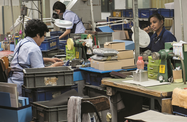A slight uptick in sales and new hires in Malaysia’s manufacturing sector indicates the country may be moving towards a rebound, though any recovery is likely to be muted, as rising costs and uncertainty over demand look set to curb growth rates.

Manufacturing index
The Nikkei Malaysia Manufacturing Purchasing Managers’ Index (PMI), a measure of manufacturing performance, remained in negative territory for October, after the PMI posted modest improvement in September.
The latest index – released at the beginning of November – put Malaysia’s PMI at 47.2, slightly lower than 48.6 in September and 47.4 in August. A score of more than 50 indicates improvement in the sector. The recent reading was the country’s lowest since June and fell below the series average of 49.5.
Among the contributing factors were market uncertainty and a decline in international demand, resulting in a drop in new orders and fewer exports of manufactured products. However, manufacturers were able to clear unfinished work and meet delivery schedules with shortened lead times resulting from a reduced number of orders.
Input prices also continued to rise in October, but at a slower rate than seen in previous months, with September recording a sharp increase, largely due to raw materials costs, unfavourable exchange rates and higher sales tax.
“The start of the final quarter of 2016 set off on a bad footing for the Malaysian manufacturing sector, with operating conditions deteriorating at a solid pace. This was driven by falls in both output and new orders, with the latter declining at the sharpest rate since November 2015. As a result, manufacturers cut back on input buying at the quickest rate in four months,” Amy Brownbill, an economist at IHS Markit, the financial services firm that prepared the PMI data for Nikkei, said in a statement.
Positive output
Despite the PMI dipping in October, Malaysia’s manufacturing sector continues to post growth and support wider industrial expansion.
The recent Index of Industrial Production (IPI) issued by Malaysia’s Department of Statistics (DoS) in mid-November showed the country’s industrial output grew moderately by 3.2% year-on-year (y-o-y) in September – compared to 4.9% y-o-y in August – primarily resulting from expansion in the manufacturing and electrical sectors.
The manufacturing sector grew by a combined 4.0%, according to provisional DoS figures for September, slightly down on the 4.6% posted in August.
Key sub-categories – such as petroleum, chemical, rubber and plastic products, which increased by 4.4%; electrical and electronics products, 6.5%; and non-metallic mineral products, basic metal and fabricated metal products, by 3.2% – drove sector growth, the IPI showed.
Manufacturing sales, meanwhile, improved slightly, reaching RM58.5bn ($13bn), representing a 1.1% y-o-y expansion.
There was also a marginal increase in sector employment, according to DoS data. In September, the number of workers rose by 0.2% y-o-y to over 1m, while wages also grew by 7.5% y-o-y, in part a reflection of the mandatory minimum wage introduced on July 1.
Hiring on the rise
Another indicator of a potential rebound in the manufacturing sector came in early October, with the publication of Monster.com’s latest Monster Employment Index (MEI) for Malaysia.
According to the MEI, which records trends in online hiring, Malaysia saw a 3% y-o-y decline in e-hiring in August. Though still in negative territory, this represented a 14% increase from July, which declined by 17% y-o-y.
Manufacturing was included in the index as one of the top growth industries, with online recruitment activity in the sector expanding by 1% y-o-y in August.
Despite the current uncertain global economic climate and the weakened ringgit, local employers are hopeful that recruitment will pick up in the months ahead, with manufacturing one of the sectors set to benefit most, according to Sanjay Modi, managing director for the Asia-Pacific and Middle-East regions at Monster.com.
“The sectors that will likely continue to see the most growth are the IT, manufacturing and retail industries,” Modi said in the MEI statement.
Oxford Business Group is now on Instagram. Follow us here for news and stunning imagery from the more than 30 markets we cover.


